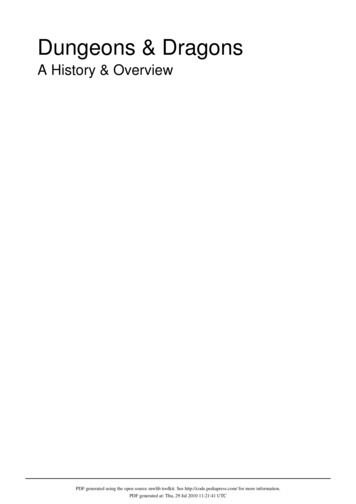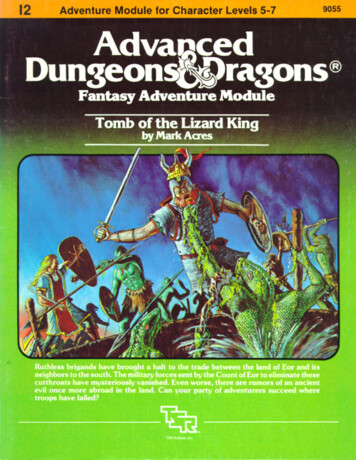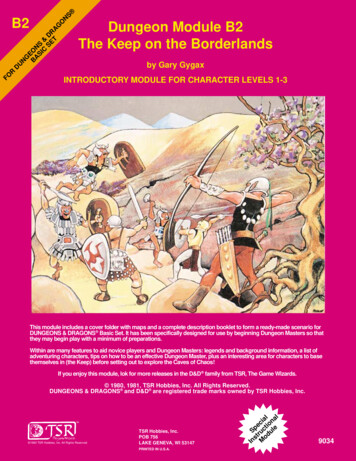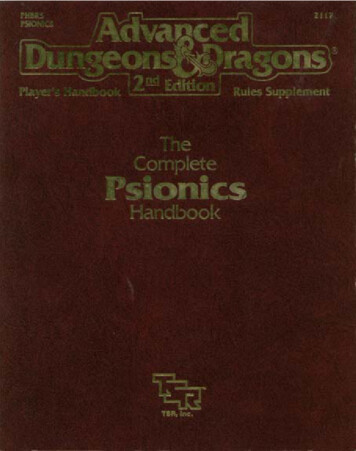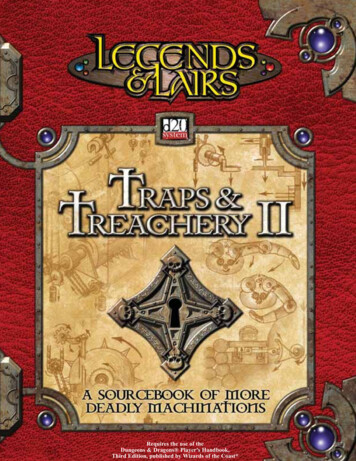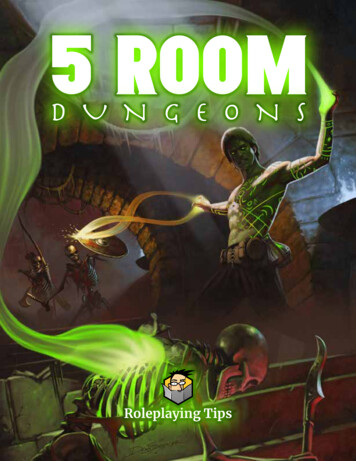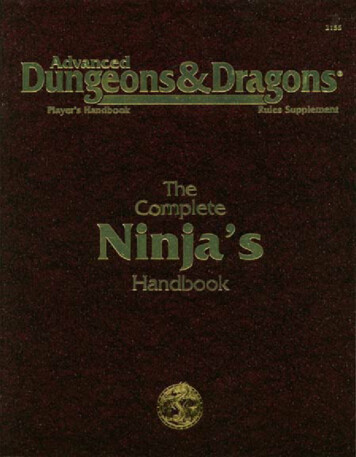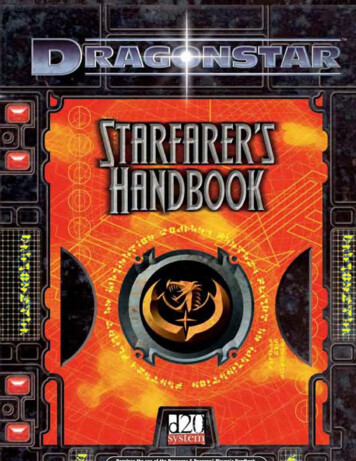
Transcription
Continue
Dungeons and dragons 3.5 edition player's handbookBack to Main Page Publication List Wizards of the Coast Wizards of the Coast reignited and reinvigorated the roleplaying game community when it released the 3rd Edition DUNGEONS & DRAGONS game in 2000. In 2003, the core game rules were revised to include errata andplaytesting feedback, and then re-released as this series of v.3.5 core rulebooks.This reprint of the v.3.5 core rulebooks keeps this popular version of the D&D game in print and available to 3rd Edition players seeking to replace their old books as well as new players seeking a 3rd Editiongame experience. This book includes the most up-to-date Player's Handbook errata. Contents Armor . 122 Table 3–11: Small or Large Monk Goods and Services. 126 Unarmed Damage.41Introduction. 4 Chapter 8: Combat. 133 Table 3–12: The Paladin.43 TABLE OF The Battle Grid. 133 Table 3–13: The Ranger .46CONTENTSCharacter Creation Summary . 6 How Combat Works. 133 Table 3–14: Ranger Favored Enemies .47 Combat Statistics. 133 Table 3–15: The Rogue.49Chapter 1: Abilities. 7 Combat Basics . 135 Table 3–16: The Sorcerer.52 Ability Scores . 7 Initiative . 136 Table 3–17: Sorcerer Spells Known .54 TheAbilities . 8 Attacks of Opportunity . 137 Table 3–18: The Wizard.55 Changing Ability Scores.10 Actions in Combat. 138 Table 4–1: Skill Points per Level.62Injury and Death. 145 Table 4–2: Skills .63Chapter 2: Races .11 Movement, Position, Table 4–3: Difficulty Class Examples .64 Choosing a Race.11 AndDistance. 146 Table 4–4: Example Opposed Checks.64 Racial Characteristics .11 Combat Modifiers. 150 Table 4–5: Skill Synergies .66 Humans .12Special Attacks. 154 Table 4–6: Example Ability Checks .66 Dwarves .14 Special Initiative Actions . 160 Table 5–1: Feats .90Elves.15 Table 6–1: Creature, Race, and Gnomes .16 Chapter 9: Adventuring . 161 Half-Elves.18 Carrying Capacity . 161Class Alignments. 104 Half-Orcs.18 Movement. 162 Table 6–2: Deities by Race . 106 Halflings.19 Exploration. 164 Table 6–3: Deities by Class. 106 Treasure. 167 Table 6–4: Random Starting Ages . 109Chapter 3: Classes.21 Other Rewards. 168Table 6–5: Aging Effects. 109 The Classes.21 Table 6–6: Random Height Class and Level Bonuses.21 Chapter 10: Magic. 169 Level-Dependent Benefits .22 CastingSpells. 169 and Weight. 109 Class Descriptions .23 Spell Descriptions. 172 Table 7–1: Random Starting Gold . 111 Barbarian .24Arcane Spells . 177 Table 7–2: Coins. 112 Bard .26 Divine Spells. 179 Table 7–3: Trade Goods. 112 Cleric.30 Special Abilities . 180 Table 7–4 Tiny and Large Druid.33 Fighter.37 Chapter 11: Spells . 181 WeaponDamage. 114 Monk .39 Bard Spells. 181 Table 7–5: Weapons. 116 Paladin.42 Cleric Spells. 183 Table 7–6: Armor and Shields. 123 Ranger .46 Cleric Domains. 185 Table 7–7: Donning Armor. 123 Rogue.49Druid Spells . 189 Table 7–8: Goods and Services. 128 Sorcerer.51 Paladin Spells . 191 Table 8–1: Size Modifiers . 134Wizard.55 Ranger Spells. 191 Table 8–2: Actions in Combat. 141 Experience and Levels .58 Sorcerer/Wizard Spells. 192 Table 8–3: Tactical Speed. 147 Multiclass Characters.59 Spells. 196 Table 8–4: Creature Size and Scale. 149 Table 8–5: Attack Roll Modifiers. 151Chapter 4: Skills .61 Appendix: GeneralGuidelines Table 8–6: Armor Class Modifiers. 151 Skill Summary .61 and Glossary . 304 Table 8–7: Special Attacks. 154 Acquiring Skill Ranks .61 Table 8–8: Common Armor,Weapon, and Using Skills .62 Index. 315 Skill Descriptions .66 Shield Hardness and Hit Points . 158 Character Sheet. 318 Table 8–9: TurningUndead . 159 Table 8–10: Two-WeaponChapter 5: Feats .87 List of Numbered Tables Acquiring Feats .87 Table 1–1: Ability Modifiers Fighting Penalties . 160Prerequisites.87 and Bonus Spells .8 Table 9–1: Carrying Capacity. 162 Types of Feats.87 Table 2–1: Racial Ability Adjustments . 12 FeatDescriptions.89 Table 3–1: Base Save and Table 9–2: Carrying Loads. 162 Base Attack Bonuses . 22Chapter 6: Description. 103 Table 3–2: Experience and Level- Table 9–3: Movement and Distance. 162 Alignment. 103 Dependent Benefits . 22 Religion . 106 Table 3–3: The Barbarian . 25 Table 9–4: Hampered Movement. 163 Vital Statistics. 109 Table 3–4: The Bard. 27 Looks, Personality, Table 3–5: Bard Spells Known . 28 Table 9–5: Terrain and Overland and Background. 110 Table 3–6: The Cleric . 31Customizing Your Character . 110 Table 3–7: Deities. 32 Movement . 164 Table 3–8: The Druid . 35Chapter 7: Equipment . 111 Table 3–9: The Fighter.39 Table 9–6: Mounts and Vehicles. 164 Equipping a Character . 111 Table 3–10: The Monk. 40 Wealth and Money . 112 Table 9–7: Light Sources Weapons. 112 andIllumination. 165 Table 9–8: Common Armor, Weapon, and Shield Hardness and Hit Points . 166 Table 9–9: Substance Hardness and Hit Points. 166 Table 9–10: Size and Armor Class of Objects .166 Table 9–11: Object Hardness and Hit Points. 166 Table 9–12: DCs to Break or Burst Items . 166 Table 10–1: Items Affected by Magical Attacks. 177 3INTRODUCTION Introduction The game assumesthe use of miniatures and a battle grid, and the rules are written from this perspective. This is the Dungeons & Dragons Roleplaying Game, the game that defines the genre and has set the standard for fantasy role- CHARACTERS playing for more than 30 years. Your characters star inthe adventures you play, just like the heroes D&D is a game of your imagination in which you participate in of a book or movie. As a player, you create a character using the rules thrilling adventures and dangerous quests by taking on the role of a in this book. Your character might be asavage barbarian from the hero—a character you create. Your character might be a strong frozen wastes or a clever rogue with a quick wit and a quicker blade. fighter or a clever rogue, a devout cleric or a powerful wizard. With a You might be a deadly archer trained in survival techniquesor a few trusted allies at your side, you explore ruins and monster-filled wizard who has mastered the arcane arts. As your character dungeons in search of treasure. The game offers endless possibilities participates in adventures, he or she gains experience and becomes and a multitude ofchoices—more choices than even the most more powerful. sophisticated computer game, because you can do whatever you can imagine. ADVENTURES THE D&D GAME Your character is an adventurer, a hero who sets out on epic quests for fortune and glory. Other characters join youradventuring party The D&D game is a fantasy game of your imagination. It’s part to explore dungeons and battle monsters such as the terrible dragon acting, part storytelling, part social interaction, part war game, and or the carnivorous troll. These quests unfold as stories created by thepart dice rolling. You and your friends create characters that develop actions your characters perform and the situations your DM and grow with each adventure they complete. One player is the presents. Dungeon Master (DM). The DM controls the monsters and ene- mies, narrates theaction, referees the game, and sets up the adven- A Dungeons & Dragons adventure features plenty of action, tures. Together, the Dungeon Master and the players make the game exciting combat, terrifying monsters, epic challenges, and all kinds come alive. of mysteries to uncover. Whatlies at the heart of the dungeons? What waits around the next corner or behind the next door? Playing This Player’s Handbook has all the rules players need to create the roles of your characters, you and your friends face the dangers characters, select equipment, and engage in combatwith a variety of and explore a world of medieval fantasy. supernatural and mythical foes. One adventure might play out in a single game session; another The Dungeon Master’s Guide, available separately, provides the DM might stretch across several sessions of play. A session lasts aslong with advice, guidelines, and everything he or she needs to create as you and your friends want to play, from a couple of hours to an all- challenges, adventures, and full-fledged D&D campaigns, including day affair. The game can be stopped at any time and picked up sections onprestige classes, magic items, and character rewards. wherever you left off when everyone gets back together. The Monster Manual, available separately, contains material that Every adventure is different, every quest unique. Your character players and DMs alike will find useful. Withhundreds of monsters might explore ancient ruins guarded by devious traps or loot the to populate all levels of dungeons, this tome also includes monster tomb of a long-forgotten wizard. You might sneak into a castle to spy creation rules, information on playing monsters as characters, onan enemy or face the life-draining touch of an undead creature. details on monster tactics, and powered-up versions of standard Anything is possible in a Dungeons & Dragons game, and your creatures. character can try to do anything you can imagine. Together, these three volumescomprise the core rules for the PLAYING THE GAME Dungeons & Dragons game. Dungeons & Dragons uses a core mechanic to resolve all actions THREE DIMENSIONS in the game. This central game rule keeps play fast and intuitive. The Dungeons & Dragons game is a game ofimagination, but it The Core Mechanic: Whenever you attempt an action that has is also a game of tactics and strategy. Miniatures and a battle grid some chance of failure, you roll a twenty-sided die (d20). To deter- provide the best way to visualize the action. Miniatures, represent- mine ifyour character succeeds at a task (such as attacking a mon- ing characters and monsters in the game, can be purchased from ster or using a skill), you do this: most hobby shops. The Dungeon Master’s Guide includes a paper battle grid. More durable versions may be purchasedseparately. WHY A REVISION? this book, rest assured that this revision is a testament to our dedication The new Dungeons & Dragons game debuted in 2000. In the three to continuous product improvement. We’ve updated errata, clarified years since the d20 Open System energies theRPG industry, we’ve rules, and made the game even better than it was. But also rest assured gathered tons of data on how the game is being played. We consider that this is an upgrade of the d20 System, not a new edition of the game. D&D to be a living game that constantly evolves as itis played. This revision is compatible with all existing products, and those products We’ve gathered feedback from as many people who have played D&D can be used with the revision with only minor adjustments. as we could. We’ve talked to you at conventions, examined countless What’snew in the revised Player’s Handbook? We’ve increased the message boards devoted to the game, and collected information from a number of feats and spells to choose from, and we’ve added new class variety of customer-response outlets including our customer service features to thebarbarian, bard, druid, monk, ranger, and sorcerer. The department. We used all this data to retool the game from the ground up entire book has been polished and refined, all in response to your feed- and incorporate everyone’s suggestions. We listened to what you had to back and toreflect the way the game is actually being played. We’ve say, and we responded enthusiastically to improve the game and this streamlined some rules, expanded others. We’ve overhauled skills and product. spells. If this is your first experience with D&D, we welcome you to a wonder- Takea look, play the game. We think you’ll like how everything turned ful world of adventure and imagination. If you used the prior version of out. 4Roll a d20. sults. The DM may make some rolls in secret to build suspense and INTRODUCTION Add any relevant modifiers. maintain mystery.Compare the result to a target number. 5 If the result equals or exceeds the target number (set by the DM WHAT CHARACTERS CAN DO or given in the rules), your character succeeds. If the result is lower than the target number, you fail. A character can try to do anything you canimagine, just as long as it fits the scene the DM describes. Depending on the situation, yourTHE RULES character might want to listen at a door, search an area, bargain with a shopkeeper, talk to an ally, jump across a pit, move, use an item, or Important: You don’t have to memorize thisbook to play the attack an opponent. game. Once you understand the basics, start playing! Use this book as reference during play. When in doubt, stick to the basics, keep Characters accomplish tasks by making skill checks, ability playing, and have fun. checks, or attack rolls, using thecore mechanic. One part of the book you may end up referring to frequently, at Skill Checks least for a while, is the glossary that begins on page 304. Here’s where you’ll find definitions of the terms we use in the rules and To make a skill check, roll a d20 and add your character’s skillinformation on how a character is affected by certain conditions modifier. Compare the result to the Difficulty Class (DC) of the task (such as being stunned). If you come across a term you’re not at hand. familiar with and you want to know more, look it up in the glossary (and also check theindex, of course). An unopposed skill check’s success depends on your result compared to a DC set by the DM or the skill’s description (seeWHAT YOU NEED TO PLAY Chapter 4). Your group needs these items to play D&D. An opposed skill check’s success depends on your result comThe Player’s Handbook, Dungeon Master’s Guide, and Monster Manual pared to the result of the character opposing your action. The revised core rulebooks. (All players might want to have their own opponent’s check might be made using the same skill or a different copies of the books.)skill, as set forth in the skill’s description. A copy of the character sheet at the back of this book for each player. Ability Checks A battle grid. The Dungeon Master’s Guide contains one. Miniatures to represent each character and the monsters that Ability checks are used when a characterdoesn’t have any ranks in a challenge them. skill and tries to use that skill untrained. (Some skills, however, can’t A set of dice for each player. A set of dice includes at least one be used untrained.) four-sided die (d4), four six-sided dice (d6), one eight-sided die (d8), two ten-sided dice(d10), one twelve-sided die (d12), and one Ability checks are also used to determine success when no skill twenty-sided die (d20). applies. Pencils, scrap paper, and graph paper to keep notes and to map the locations your characters will explore. To make an ability check, roll a d20 andadd your character’s modifier for the appropriate ability.DICE Attack Rolls We describe dice rolls with expressions such as “3d4 3,” which means “roll three four-sided dice and add 3” (resulting in a number To attack an opponent, roll a d20 and add your character’s attack between 6 and 15).The first number tells you how many dice to roll bonus. If the result equals or exceeds the opponent’s Armor Class (adding the results together). The number immediately after the “d” (AC), the attack succeeds. tells you the type of dice to use. Any number after that indicates a quantity that isadded or subtracted from the result. Some examples On a successful attack, roll the dice indicated for the weapon you include: used to determine how much damage your attack deals. 1d8: One eight-sided die, generating a number from 1 to 8. This is Damage reduces hit points (hp). Whenall of a character’s hit the amount of damage a longsword deals. points are gone, the character falls unconscious and is dying. (See Chapter 8: Combat for details.) 1d8 2: One eight-sided die plus 2, generating a number from 3 to 10. A character with a 2 Strength bonus deals this amountof A critical hit deals more damage. If you roll a natural 20 on an damage when using a longsword. attack roll, you threaten a critical hit. Roll again to confirm it. If the second attack roll is successful, then the critical hit is confirmed and 2d4 2: Two four-sided dice plus 2, resulting in a numberfrom 4 you deal more damage (see page 140 for more information). to 10. This is the amount of damage a 3rd-level wizard deals with a magic missile spell. THE COMBAT ROUND d%: Percentile dice work a little differently. You generate a Combat is played in round. Each roundrepresents 6 seconds in the number between 1 and 100 by rolling two different-colored ten- game world, regardless of how long it takes to play out the round. sided dice. One color (designated before you roll) is the tens digit. Combat starts with initiative checks to determine the order of playThe other is the ones digit. A roll of 7 and 1, for example, give you a for the entire battle. There are three types of actions: standard result of 71. Two 0s represents 100. Some percentile show the tens actions, move actions, and full-round actions. In a round, you can do digit in tens (00, 10,20, etc.) and the ones digit in ones (0, 1, 2, etc.). one of these four things: Take a standard action and then a move In this case, a roll of 70 and 1 is 71, and 00 and 0 is 100. action; take a move action and then a standard action; take two move actions; or perform a full-round action. (SeeChapter 8: Combat for Important! Not every action requires a die roll. Roll dice in details.) combat and other dramatic situations when success is never a cer- tainty. THE PLAYER’S ROLE The d20 is used to determine whether or not your character suc- As a player, you use this handbook tocreate and run a character. ceeds at an action. The other dice are used to determine what hap- Your character is an adventurer, part of a team that regularly delves pens after you succeed. into dungeons and battles monsters. Play wherever everyone feels comfortable and there’s a placeto set the battle grid and miniatures, Players should roll dice openly so that everyone can see the re- roll the dice, and spread out your books and character sheets. The DM sets each scene and describes the action. It’s your job to decide what your character is like, how he or she relates tothe other adventurers, and act accordingly. You can play a serious paladin or aINTRODUCTION wisecracking rogue, a reckless barbarian or a cautious wizard. With ahead about upcoming character creation steps. Feel free to look your character in mind, respond to each situation as itcomes up. ahead or to backtrack and do something over if you need to. Sometimes combat is called for, but other situation might be solved through magic, negotiation, or judicious skill use. SELECT SKILLS Also consider how you respond. Do you narrate your character0s Your character’sclass and Intelligence modifier determine how action (“Tordek moves to the doorway and attacks the bugbear”) or many skill points you have to buy skills (see page 62). speak as your character (“I move to the doorway and take a mighty swing at the monster”)? Either method is fine, andyou can even vary Skills are measured in ranks. Each rank adds 1 to skill checks your approach to match the situation. made using a specific skill. D&D is a social experience as well as an imaginative one. Be At 1st level, you can buy as many as 4 ranks in a class skill (a skill creative, bedaring, and be true to your character and most of all, on your class’s list of class skills) for 4 skill points, or as many as 2 have fun! ranks in a cross-class skill (a skill from another class’s list of class skills) for the same cost. (You get more out of purchasing class CHARACTER CREATIONskills.) Review Chapters 1 through 5, then follow these steps to create a 1st- Buying skills goes faster if you spend 4 skill points (your maxi- level character. You need a photocopy of the character sheet, a mum) on every skill you buy, as we’ve done in the starting packages. pencil, scrappaper, and four 6-sided dice. Once you’ve selected your skills, determine the skill modifier for CHECK WITH YOUR DUNGEON MASTER each one. To do this, add the skill ranks to the ability modifier associated with the skill and record it on your character sheet. Your DM may have houserules or campaign standards that vary from these rules. You should also find out what the other players Table 4–2: Skills (page 63) lists all the skills in the game and have created so that your character fits into the group. indicates which skills are class skills for which classes. ROLL ABILITYSCORES SELECT A FEAT Roll your character’s six ability scores. Determine each one by Each 1st-level character starts with a feat. Table 5–1: Feats (page 90) rolling four six-sided dice, ignoring the lowest die roll, and totaling lists all feats, their prerequisites (if any), and a briefdescription. the other three. Record your six results on scrap paper. REVIEW DESCRIPTION CHAPTER See Chapter 1 (beginning on the next page) for more details. Look over Chapter 6: Description. It helps you detail your character. You can this now or wait until later. CHOOSE YOURCLASS AND RACE SELECT EQUIPMENT Choose your class and race at the same time, because some races are Use the equipment from your class’s starting package, or randomly determine your starting gold (see page 111) and buy your own gear better suited to certain classes. Theclasses, detailed in Chapter 3, are piece by piece, using the information in Chapter 7: Equipment. barbarian, bard, cleric, druid, fighter, monk, paladin, ranger, rogue, sorcerer, and wizard. Each class description includes a “Races” section that provides some advice. The Races, described inChapter 2, are human, dwarf, elf, gnome, RECORD COMBAT NUMBERS halflings, half-elf, and half-orc. Write your class and race selections on your character sheet. Determine these statistics and record them on your character sheet. Hit Points: Your hit points (hp) determine how hardyour character is to kill. At 1st level, wizards and sorcerers get 4 hp; ASSIGN AND ADJUST ABILITY SCORES rogues and bards get 6 hp; clerics, druids, monks, and rangers get 8 Now that you know your character’s class and race, take the ability hp; fighters and paladins get 10 hp; andbarbarians get 12 hp. To this scores you rolled earlier and assign each to one of the six abilities: number, add you character’s Constitution modifier. Strength, Dexterity, Constitution, Intelligence, Wisdom, and Armor Class: Your Armor Class (AC) determines how hard your Charisma. Adjustthese scores up or down, according to your race, as character is to hit. Add the following numbers together to get your indicated on Table 2–1: Racial Ability Adjustments (page 12). AC: 10 your armor bonus your shield bonus your size modifier Put high scores in abilities that supportyour class selection. Each your Dexterity modifier. class description includes an “Abilities” section that provides some Initiative: Your character’s initiative modifier equals your advice. Dexterity modifier. The Improved Initiative feat provides an For each ability score, record the character’smodifier, as indicated additional modifier if you select it. on Table 1–1: Ability Modifiers and Bonus Spells (page 8). Ability Attack Bonuses: Your class determines your base attack bonus. modifiers adjust many die rolls in the game, including attack rolls, To determine your melee attackbonus for when you get into close- damage rolls, skill checks, and saving throws. combat fights, add your Strength modifier to your base attack bonus. Record your adjusted ability scores and their modifiers on your To determine your ranged attack bonus for when you attack from acharacter sheet. distance, add your Dexterity modifier to your base attack bonus. S
Dungeons and dragons 3.5 edition player's handbook Back to Main Page Publication List Wizards of the Coast Wizards of the Coast reignited and reinvigorated the roleplaying game community when it released the 3rd Edition DUNGEONS & DRAGONS game in 2000. In 2003, the core game rules were revised to include errata and
